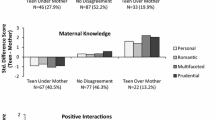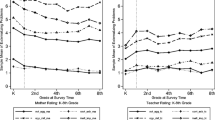Abstract
The goal of the current study was to examine the role number of children in a family has on the discrepancy between mother- and teacher-reported externalizing problems. A total of 243 youth and mothers (Mage = 9.92 ± 2.84 years; age range: 8–16 years; 129 males and 114 females) presented for a psychological evaluation. Behavioral reports were gathered from the Child-Behavior Checklist and the Teacher Rating Form. A factorial analysis of variance first tested for mean-level discrepancies between informant reports across four sibling groups. Next, a polynomial regression analysis tested rank-order discrepancies as a function of sibling groups. Results indicated that mother-teacher mean-level discrepancies did not differ as a function of the number of children in the household. In contrast, rank-order discrepancies did differ across sibling groups; mothers with fewer children had higher congruence with teacher-reported externalizing problems. Overall, mother-teacher rank-order agreement was greatest when the child was an only child and decreased modestly with the first and each additional sibling. We discuss these findings in light of previous literature and provide direction for future literature examining mother-teacher informant discrepancies.
Highlights
-
The number of children in a family is related to differences in mother- and teacher-reported externalizing problems.
-
Rank-order discrepancies differed across sibling groups; mothers with fewer children had highest congruence with teacher-report.
-
Mother-teacher rank-order agreement was greatest when the child was an only child, decreasing with each additional sibling.
-
Mean-level mother-teacher discrepancies did not differ as a function of the number of children.
Similar content being viewed by others
References
Achenbach, T. M. (1991a). Manual for the child behavior checklist 4-18 & 1991 profile. Burlington, VT: University of Vermont Department of Psychiatry.
Achenbach, T. M. (1991b). Manual for the teacher’s report form & 1991 profile. Burlington, VT: University of Vermont Department of Psychiatry.
Achenbach, T. M. (2006). As others see us: clinical and research implications of cross-informant correlations for psychopathology. Current Directions in Psychological Science, 15, 94–98.
Chen, W. J., Faraone, S. V., Biederman, J., & Tsuang, M. T. (1994). Diagnostic accuracy of the Child Behavior Checklist scales for attention-deficit hyperactivity disorder: a receiver operating characteristic analysis. Journal of Consulting and Clinical Psychology, 62, 1017–1025.
Collishaw, S., Goodman, R., Ford, T., Rabe-Hesketh, S., & Pickles, A. (2009). How far are associations between child, family and community factors and child psychopathology informant-specific and informant-general? Journal of Child Psychology and Psychiatry, 50, 571–580.
De Los Reyes, A. (2011). Introduction to the special section: more than measurement error: discovering meaning behind informant discrepancies in clinical assessments of children and adolescents. Journal of Clinical Child & Adolescent Psychology, 40(1), 1–9.
De Los Reyes, A., Augenstein, T. M., Wang, M., Thomas, S. A., Drabick, D. A., Burgers, D. E., & Rabinowitz, J. (2015). The validity of the multi-informant approach to assessing child and adolescent mental health. Psychological Bulletin, 141(4), 858–900.
Downey, D. B., & Condron, D. J. (2004). Playing well with others in kindergarten: the benefit of siblings at home. Journal of Marriage and Family, 66, 333–350.
Edwards, J. R. (1994). The study of congruence in organizational behavior research: critique and a proposed alternative. Organizational Behavior and Human Decision Processes, 58, 51–100. https://doi.org/10.1006/obhd.1994.1029.
Gagnon, C., Vitaro, F., & Tremblay, R. E. (1992). Parent-teacher agreement on kindergarteners’ behavior problems: a research note. Journal of Child Psychology and Psychiatry, 33, 1255–1261.
Ganzach, Y. (1997). Misleading interaction and curvilinear terms. Psychological Methods, 2(3), 235–247.
George, D., & Mallery, M. (2010). SPSS for windows step by step: A simple guide and reference, 17.0 update. 10a ed. Boston: Pearson.
Harvey, E. A., Fischer, C., Weieneth, J. L., Hurwitz, S. D., & Sayer, A. G. (2013). Predictors of discrepancies between informants’ ratings of preschool-aged children’s behavior: an examination of ethnicity, child characteristics, and family functioning. Early Childhood Research Quarterly, 28(4), 668–682.
Hunsley, J., & Mash, E. J. (2007). Evidence-based assessment. Annual Reviews in Clinical Psychology, 3, 29–51.
Jensen, P. S., Xenakis, S. N., Davis, H., & Degroot, J. (1988). Child psychopathology rating scales and interrater agreement: II. Child and family characteristics. Journal of the American Academy of Child and Adolescent Psychiatry, 27, 451–461.
Johns, G. (1981). Difference score measures of organizational behavior variables: A critique. Organizational Behavior and Human Performance, 27(3), 443–463.
Laird, R. D., & De Los Reyes, A. (2013). Testing informant discrepancies as predictors of early adolescent psychopathology: why difference scores cannot tell you what you want to know and how polynomial regression may. Journal of Abnormal Child Psychology, 41, 1–14.
Lawson, G. M., Nissley-Tsiopinis, J., Nahmias, A., McConaughy, S. H., & Eiraldi, R. (2017). Do parent and teacher report of ADHD symptoms in children differ by SES and racial status? Journal of Psychopathology and Behavioral Assessment, 39(3), 426–440.
Leung, J. T. Y., & Shek, D. T. L. (2014). Parent-adolescent discrepancies in perceived parenting characteristics and adolescent developmental outcomes in poor Chinese families. Journal of Child and Family Studies, 23(2), 200–213.
Leung, J. T. Y., & Shek, D. T. L. (2016). Parent-child discrepancies in perceived parental sacrifice and achievement motivation of Chinese adolescents experiencing economic disadvantage. Child Indicators Research, 9(3), 683–700.
Leung, J. T. Y., Shek, D. T. L., & Lin, L. (2017). Mother-child discrepancy in perceived parental control and adolescent filial piety in poor single-mother families. Journal of Adolescence, 60, 1–10.
Simonoff, E., Pickles, A., Hervas, A., Silberg, J. L., Rutter, M., & Eaves, L. (1998). Genetic influences on childhood hyperactivity: Contrast effects imply parental rating bias, not sibling interaction. Psychological Medicine, 28(4), 825–837.
Author information
Authors and Affiliations
Corresponding author
Ethics declarations
Conflict of Interest
The authors declare that they have no conflict of interest.
Ethical Approval
All procedures performed in studies involving human participants were in accordance with the ethical standards of the institutional and/or national research committee and with the 1964 Helsinki declaration and its later amendments or comparable ethical standards.
Informed Consent
Informed consent was obtained from all individual participants included in the study.
Additional information
Publisher’s note Springer Nature remains neutral with regard to jurisdictional claims in published maps and institutional affiliations.
Rights and permissions
About this article
Cite this article
Castagna, P.J., Laird, R.D., Calamia, M. et al. A Basis for Comparison: The Congruence of Mother-Teacher Ratings of Externalizing Behavior as a Function of Family Size. J Child Fam Stud 29, 3335–3341 (2020). https://doi.org/10.1007/s10826-020-01843-w
Accepted:
Published:
Issue Date:
DOI: https://doi.org/10.1007/s10826-020-01843-w




